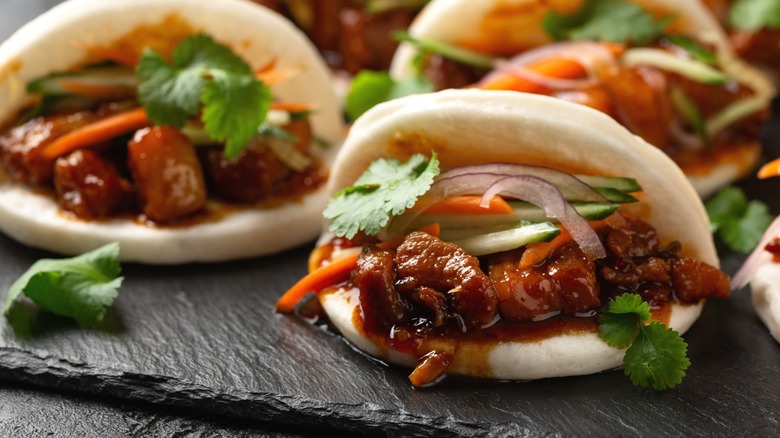What Is A Bao Bun And How Is It So Fluffy?
One of the great things about international cuisine is that just about every culture has at least one dish involving meat wrapped in dough. Mexico has tamales, the United Kingdom has Cornish pasties, Poland has pierogis, and China? Well, China has a whole bunch of dishes like that, not the least of which are bao buns. (You may remember it from a Pixar short film made by future "Turning Red" director Domee Shi.) What's the difference between bao and dumplings, and how do they get them so darn fluffy? We asked Doris Yuen, co-owner of the James Beard-nominated MAKfam in Denver, who told us everything we needed to know.
"A bao bun is an open faced bread that you can fill with protein or veggies and eat like a taco," Yuen says. Dumplings, on the other hand, "have a meat or veggie mixture enclosed, and are smaller in shape." (To be clear, there are versions of bao buns which are enclosed — what Yuen refers to is specifically gua bao.)
Another difference is that bao buns and dumplings are made with different kinds of dough. "Bao dough is leavened, making it soft, fluffy, and bread-like. Dumpling wrappers are unleavened, resulting in a chewier, thinner skin." Because of these differences in dough, their taste differs. While bao often has heartier fillings, "dumplings have a more delicate flavor." (That delicate flavor means there are mistakes you'll want to avoid with homemade chicken and dumplings.)
How does bao dough get so fluffy?
If you've ever had a bite of a bao bun, you know just how fluffy they are. When they're made right (if you'll forgive the cliche), it really is like biting into a cloud with a savory center. How do cooks manage to get that singular texture? Yuen tells us how. First up, the leavening process. "Yeast and baking powder are what give the dough that lift — they create little air pockets that make it soft and pillowy," she says. Sugar, meanwhile, "helps feed the yeast" and "keeps the dough tender and locks in moisture." Of course, "flour is the base that holds it all together."
Proofing the dough "gives the dough time to rise so the yeast can do its job." Yuen cautions against rushing the process. "If you don't let it proof enough, you'll end up with something heavy and flat." Finally, there's the matter of steaming, a popular cooking method in Chinese cuisine which you can utilize at home without a fancy steaming basket. "Steaming is what sets the texture. Because there's no dry heat, the dough stays moist and soft while still cooking through." Because of this, bao buns are usually steamed to achieve that signature texture, but "they can also be baked or pan-fried."

